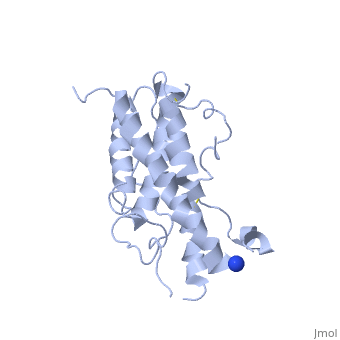Sandbox Reserved 1661
From Proteopedia
| Line 7: | Line 7: | ||
== Structure == | == Structure == | ||
| - | <Structure load='1hgu' size='350' frame='true' align='right' caption='Representation of the 3D structure of somatotropin' scene=' | + | <Structure load='1hgu' size='350' frame='true' align='right' caption='Representation of the 3D structure of somatotropin' scene='<scene name='86/868194/Lh/1'>hydrogen bonds</scene>' /> |
Somatotropin has three major isoforms. The predominant form is composed out of 191 amino acids and has a molecular weight of 22 kDa. | Somatotropin has three major isoforms. The predominant form is composed out of 191 amino acids and has a molecular weight of 22 kDa. | ||
The '''primary structure''', corresponding to a sequence of amino acids, of the predominant somatotropin is the following : | The '''primary structure''', corresponding to a sequence of amino acids, of the predominant somatotropin is the following : | ||
PUT IMAGE | PUT IMAGE | ||
| - | Somatotropin does not exist as a linear chain of amino acids, it twists and folds on itself, forming the '''secondary structure'''. The protein consists of four antiparallel aligned <scene name='86/868194/Halpha/1'>α-helices</scene> in an up-up-down-down manner <ref name="Endokrynologika Polska">DOI:10.5603/EP.2013.0009</ref>. The first helix starts at the 6th amino acid, which is a leucine and ends with the 37th amino acid proline. It is separated from the other three helices after the 37th position. The 38th and 39th amino acids, which are lysine and glutamic acid are spliced out of the protein and therefore disconnects the first helix from the second one. The second helix starts at position 72 till 92, the third from 106 till 128 and the fourth helix from 155 until 184. All helices are ampipathic with strong hydrophobic regions, especially helix 2 is very hydrophobic. The hydrophobic protein core is usually tigthly packed and any mutations in the hidden positions lead to destablilization <ref name="pubMed">PMID:17584122</ref>. | + | Somatotropin does not exist as a linear chain of amino acids, it twists and folds on itself, forming the '''secondary structure'''. The protein, made up of a single chain, consists of four antiparallel aligned <scene name='86/868194/Halpha/1'>α-helices</scene> in an up-up-down-down manner <ref name="Endokrynologika Polska">DOI:10.5603/EP.2013.0009</ref>. The first helix starts at the 6th amino acid, which is a leucine and ends with the 37th amino acid proline. It is separated from the other three helices after the 37th position. The 38th and 39th amino acids, which are lysine and glutamic acid are spliced out of the protein and therefore disconnects the first helix from the second one. The second helix starts at position 72 till 92, the third from 106 till 128 and the fourth helix from 155 until 184. All helices are ampipathic with strong hydrophobic regions, especially helix 2 is very hydrophobic. The hydrophobic protein core is usually tigthly packed and any mutations in the hidden positions lead to destablilization <ref name="pubMed">PMID:17584122</ref>. |
From the secondary structure, we obtain the '''tertiary structure''', which corresponds to the 3D structure adopted by all the alpha helixes. The structural maintenance is stabilised by electrostatic, hydrophobic and polar interactions, <scene name='86/868194/Lh/1'>hydrogen bonds</scene> and/or covalent interactions with cysteine 53 and cysteine 165 that form a <scene name='86/868194/Pds/2'>disulphide bridge</scene> as well as cysteine 182 with cysteine 189. | From the secondary structure, we obtain the '''tertiary structure''', which corresponds to the 3D structure adopted by all the alpha helixes. The structural maintenance is stabilised by electrostatic, hydrophobic and polar interactions, <scene name='86/868194/Lh/1'>hydrogen bonds</scene> and/or covalent interactions with cysteine 53 and cysteine 165 that form a <scene name='86/868194/Pds/2'>disulphide bridge</scene> as well as cysteine 182 with cysteine 189. | ||
The protein has two different binding sites: both located at the ends of the protein, the N-terminus as well as the C-terminus. | The protein has two different binding sites: both located at the ends of the protein, the N-terminus as well as the C-terminus. | ||
Revision as of 19:08, 14 January 2021
Somatotropin and Genetic origin
Somatotropin (GH for Growth Hormone or HGH for Human Growth Hormone) is a polypeptide hormone produced by the somatotropic cells of the pituitary gland. The human growth hormone complex, a protein circulating in the blood, consists of five similiar genes located over a distance of 50 kbp on the long arm of chromosome 17 [1]. There it gets encoded by the Growth hormone 1 gene along with four other related genes (hGH-N, hCS-A, hCS-B, hGH-V [1]). Three of these genes are encoding human chorionic somatomammotropin, which is closely related to somatotropin. They are all in the same transcriptional orientation.
Functions
Somatropin plays an important role in physiological environments such as: increasing muscle mass, reducing fat mass, providing the energy necessary for tissue growth, maintaining the right level of glucose and lipids... and the development of the individual's body [2]. It acts directly on a cell surface or indirectly. In the second case, somatotropin stimulates tissues such as the liver, which in turn allows the synthesis and secretion of IGF-1, thus enabling the development of cell growth, tissue, bone and thus the linear growth of the individual.[3]
Structure
| |||||||||||

